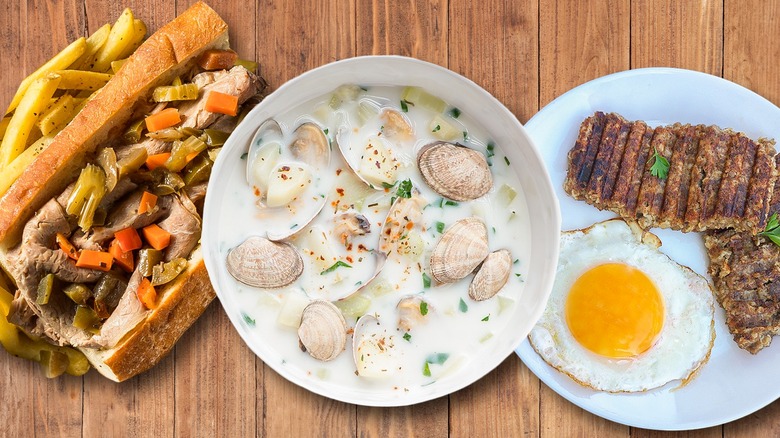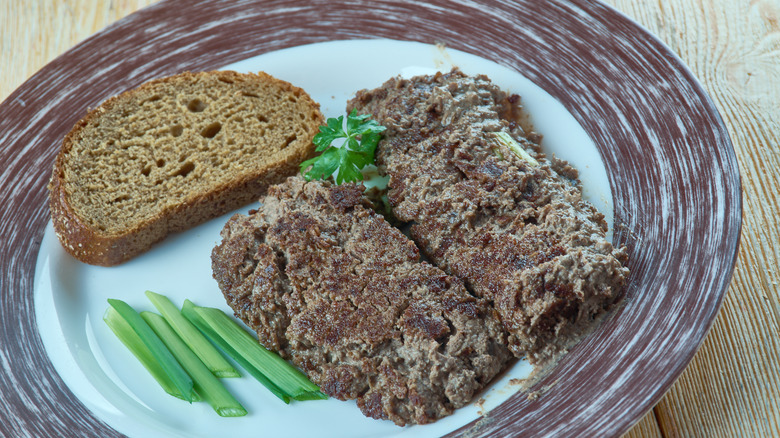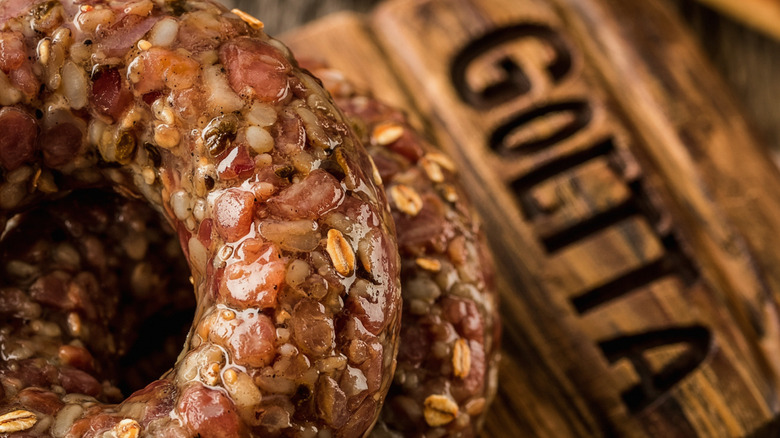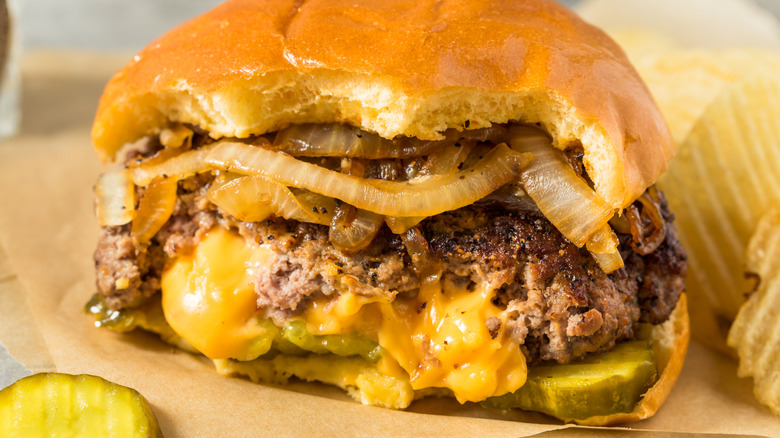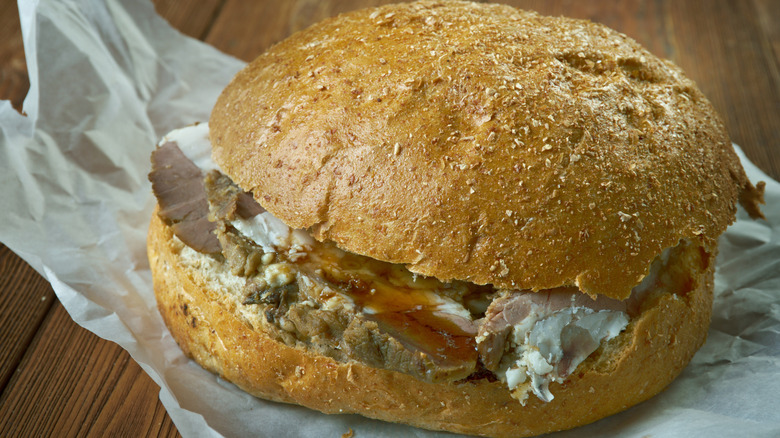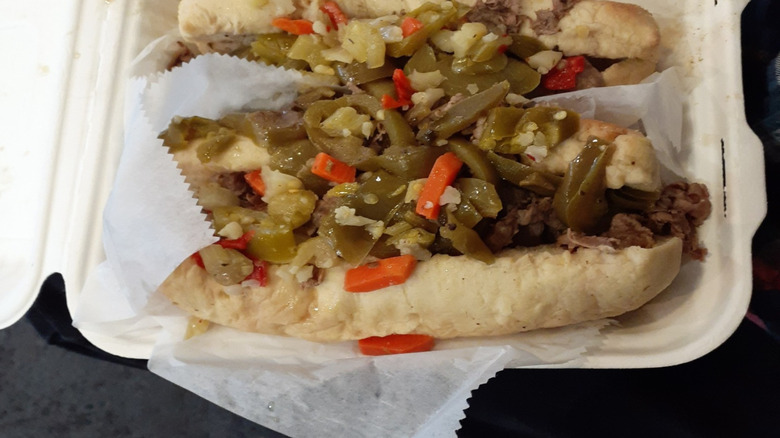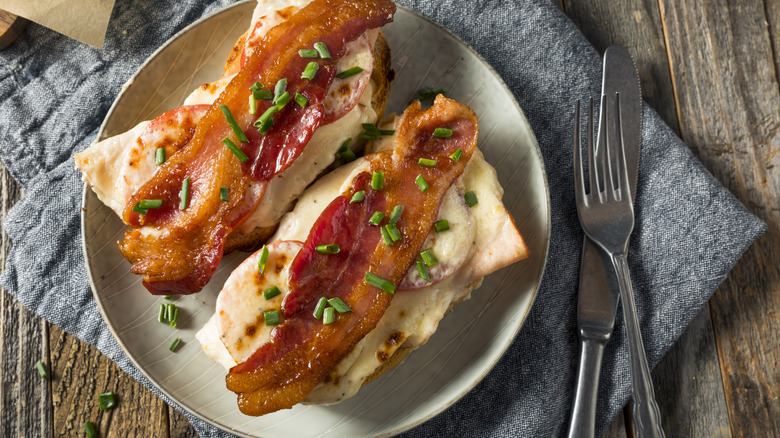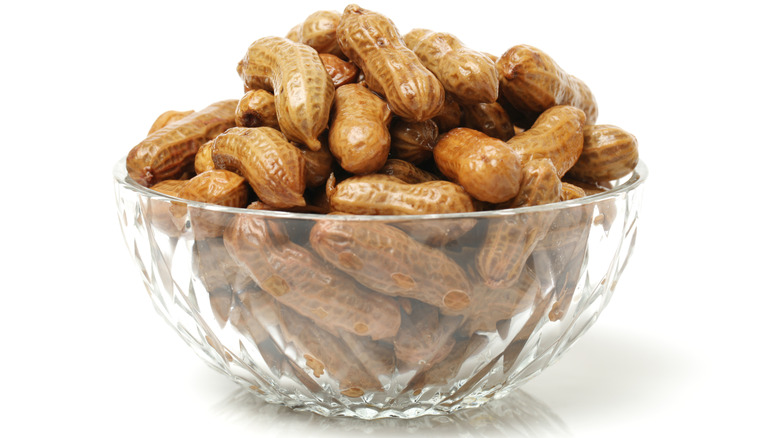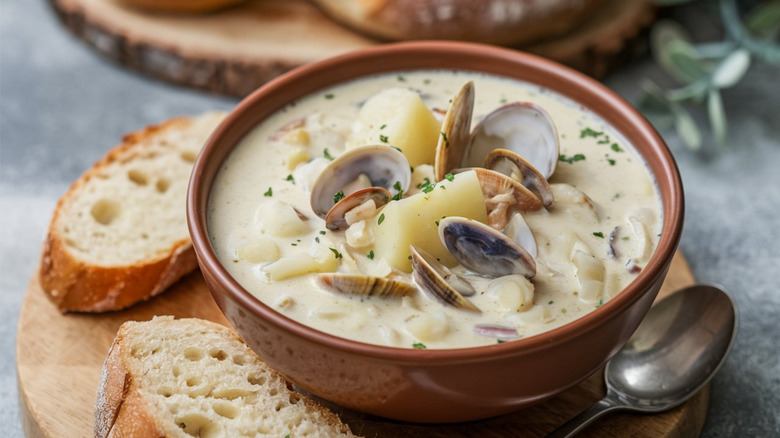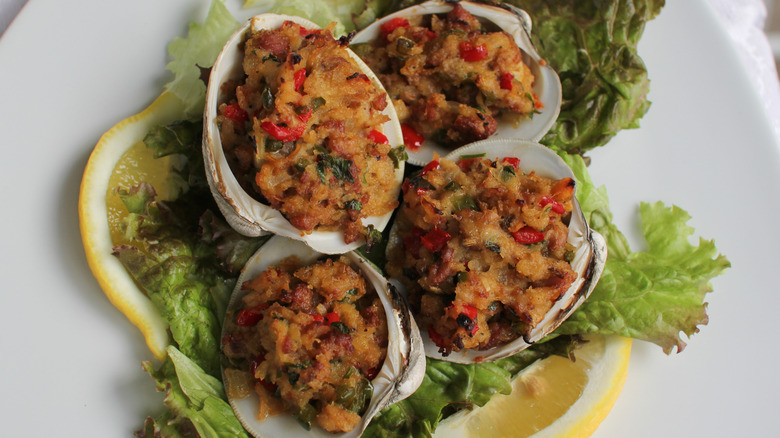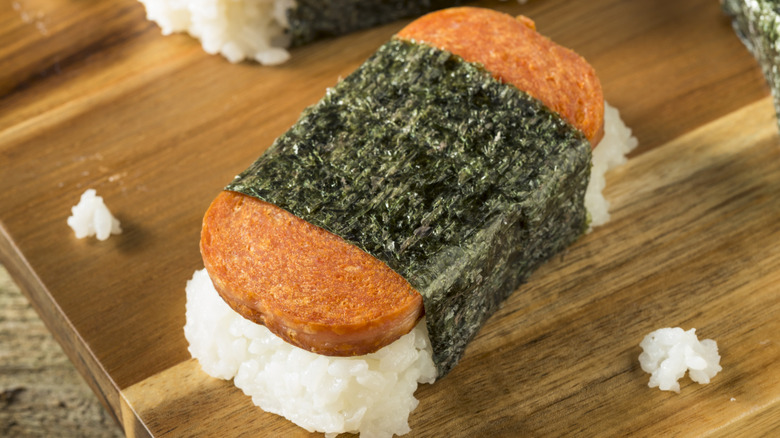11 Tried-And-True Regional Food Classics In The United States
From the sizzling bite of a juicy lucy in Minneapolis to the sweet nostalgia of Maine whoopie pies, regional American food is about far more than just physical sustenance. It's identity on a plate. All across the United States, generations have perfected dishes that speak to the local soil, the immigrant influence, and sometimes, pure necessity. These aren't fleeting Instagram fads, but the kind of eats you'll still find in mom-and-pop diners, at church fundraisers, and served in hole-in-the-wall cozy cafes that haven't changed their menu in decades.
In the South, peanuts are slow-boiled until creamy and briny, a snack that feels like summer in a paper bag. In Hawaii, Spam musubi wraps a wartime pantry staple in sushi seaweed and rice, transforming it into an island icon. Head to Chicago, and you'll meet the Italian beef, a dripping, beef-laden sandwich that could never be replicated in any chain shop outside city limits. Each of these dishes carries a story, one of migration, adaptation, invention, or simply making the best of what was available.
Together, they form a delicious map of the country, proof that regional food is often our most enduring form of storytelling. So loosen your belt, pack your appetite, and join us for a road trip through America's tastiest traditional fare.
1. Liver mush (North Carolina)
In certain pockets of North Carolina, particularly in the foothills and western part of the state, liver mush isn't just breakfast, but a birthright. Made from pork liver, head meat, and cornmeal, this loaf is seasoned, cooked, chilled, sliced, and usually fried until the edges crisp. To outsiders, the name may not sound too appetizing, but to locals, it's the ultimate comfort food.
It has roots in German settlers' scrapple, adapted over time to fit the Southern pantry and pork-loving culture. While its popularity peaked in the early 20th century, it remains a staple at diners and North Carolina festivals to this day. You'll find it tucked inside a biscuit, served on white bread with a smear of mustard, or plated alongside eggs and grits.
Many North Carolinians swear by specific brands, and debates over texture, spice level, and cooking method can get heated. The town of Shelby even hosts an annual Liver Mush Festival, where you can watch cooking demos, sample sandwiches, and hear bluegrass music. It's a dish that never tried to be glamorous — it just quietly stayed part of the community. For locals, the smell of liver mush frying in a cast-iron pan is a reminder of home, childhood, and tradition.
2. Goetta (Cincinnati, Ohio)
Goetta is more than an item on the breakfast menu in Cincinnati. If you ask a local, it's basically heritage on a plate. This sausage-like loaf blends ground pork and beef with steel-cut oats and spices, then gets sliced and fried until crisp on the outside and soft within. Brought over by German immigrants in the 19th century, goetta was a frugal way to stretch meat while delivering a hearty, flavorful meal. Locals usually serve it alongside eggs and toast, though its uses have expanded to span from everything to goetta grilled cheese, goetta pizza, and even goetta-stuffed omelets.
Unlike scrapple, its Mid-Atlantic cousin, goetta's defining feature is those chewy, nutty oats. The city celebrates its love with Goettafest, where more than dozens of vendors dream up new ways to showcase the dish. It's so embedded in local culture that some Cincinnatians will argue their preferred brand is the "real" goetta, dismissing all others.
While you can buy it in grocery stores across the region, the best experience is pulling up to a small diner counter on a Saturday morning, the smell of sizzling goetta mingling with coffee in the air. It's not just food. It's Cincinnati's way of honoring the resourcefulness and traditions of its immigrant past, still thriving in every crispy bite.
3. Juicy Lucy (Minneapolis, Minnesota)
Bite into a Juicy Lucy, and you'll quickly realize this isn't your ordinary cheeseburger. In this Minnesota classic, the cheese isn't on top, but rather inside the burger patty, melting into a molten core that oozes out everywhere from the very first bite. Origin stories vary, with two Minneapolis bars (Matt's Bar and the 5-8 Club) claiming to have invented it in the 1950s. The rivalry is friendly but fierce, and locals tend to pledge allegiance to one spot.
Ordering a Juicy Lucy requires a little patience: the thick patty needs extra time on the grill to fully cook the inside cheese. One tip from the pros is to wait a minute before biting, or risk a scalding cheese burn (it's practically a rite of passage).
The concept is simple, but the execution is pure comfort food genius. The cheese can be American, cheddar, pepper jack, or a blend, and toppings vary, but the essence remains the same. Simply put, the Juicy Lucy is one mega-burger with a surprise inside. Today, you can find Juicy Lucys all over Minneapolis and beyond, but like any regional icon, it's best experienced at its birthplace, served with a pile of fries and a local beer. It's the kind of Midwestern invention that's hearty, humble, and deeply satisfying.
4. Beef on weck (Buffalo, New York)
To understand Buffalo beyond its famous wings, you need to meet beef on weck. This sandwich pairs thinly sliced roast beef (juicy, rosy, and often served rare), with a kummelweck roll, a crusty bun topped with coarse salt and caraway seeds. The roll isn't just a bread choice, but the defining element, adding a savory crunch that balances the beef's richness. Many locals dip the sandwich in au jus or add a smear of horseradish for heat.
The dish's roots trace back to German immigrants, with one German baker named William Wahr believed to have brought the kummelweck roll to Buffalo in the mid-19th century. Today, it's a pub staple, often enjoyed with a cold beer in a cozy corner booth.
While it's beloved across Western New York, beef on weck rarely appears far outside the region, making it a must-try when you're in town. For Buffalonians, it's not just lunch, but a point of pride that is as emblematic of the city as snowstorms and die-hard Bills fans.
5. Italian beef (Chicago, Illinois)
In Chicago, the Italian beef isn't just a sandwich, but a rite of passage. Paper-thin slices of slow-roasted beef are piled high onto a crusty Italian roll, then doused (or "dipped," if you know the local lingo) in savory, aromatic jus. The magic is in the balance act of it all: tender beef, chewy bread, and just the right amount of oh-so-satisfying sogginess.
The sandwich traces back to Italian immigrants in the early 20th century, who worked in stockyards and slaughterhouses. Using inexpensive cuts of beef, they slow-cooked the meat, sliced it thin to stretch portions, and dunked it in its own juices for flavor. It caught on fast, becoming a staple at weddings, banquets, and street stands.
Today, customization is key. Order an Italian beef sandwich "sweet" with roasted peppers, "hot" with giardiniera, or "combo" with Italian sausage tucked inside. The bread is sturdy enough to hold up, but still absorbs that rich broth, turning the whole thing into a glorious, messy experience. Eating one gracefully is impossible, and that's kinda the point. Whether you're standing at a counter in Al's Beef or another neighborhood joint that's been serving them for generations, the Italian beef is a taste of Chicago's working-class history, still thriving between two halves of a roll.
6. Hot Brown (Louisville, Kentucky)
If you find yourself in Louisville, skip the fried chicken clichés and order a Hot Brown. This decadent, open-faced sandwich was born in 1926 at the historic Brown Hotel. It was created by chef Fred Schmidt as a late-night alternative to ham and eggs for the hotel's lively dance crowd. His solution? Toasted bread layered with roasted turkey, smothered in a rich, creamy Mornay sauce, then topped with crispy bacon and tomatoes. The whole dish is broiled until bubbling and golden. The result is indulgent without apology.
The Hot Brown quickly became a local legend, beloved for both its flavor and its theatrical presentation. While it's been copied and reimagined, the Brown Hotel still serves the original recipe, attracting visitors from around the world. It's the kind of meal that blurs the line between dinner and comfort food, a true Southern showstopper.
These days, you'll find variations everywhere, from mini versions at cocktail parties to creative spins at modern bistros. No matter what spin you take for a spin, the essence remains the same: a hot, cheesy, savory plate that demands a fork and a nap afterward. Order one, and you're tasting a slice of Louisville history that hasn't gone out of style in nearly a century.
7. Boiled peanuts (Deep South)
In the Deep South, the unofficial snack of summer is boiled peanuts. For those unfamiliar with this Southern delicacy, imagine green (raw) peanuts simmered in salted water until they transform into tender, briny bites. These little treasures are often sold from roadside stands, gas stations, and farmers markets, scooped into paper bags that leave your hands deliciously damp.
This tradition has deep roots. According to local lore, peanuts arrived in the region via the transatlantic slave trade, and boiling them was a preservation method as well as a flavor booster. By the late 19th century, they were a social snack, shared at baseball games, political rallies, and family gatherings.
Unlike roasted peanuts, the boiled version has a soft, almost bean-like texture, and the salt seeps into every bite. You eat them by cracking the shell with your teeth and sucking out the juicy peanut inside (bonus points if you also enjoy the salty brine).
While every boiled peanuts fan has an opinion on the perfect seasoning (some add Cajun spices or garlic), plain salted remains the classic go-to preference. They're best eaten hot, but even cold, they carry that unmistakable taste of the South's agricultural heritage and communal spirit. For many, a bag of boiled peanuts means a long drive, a front porch, and an unhurried afternoon.
8. New England clam chowder (New England)
Thick, creamy, and brimming with tender clams, New England clam chowder is not your average, ordinary soup. Ask any local New Englander, and they will let you know in no vague terms that it's a maritime tradition. Made with clams, potatoes, onions, and milk or cream, it's famously rich and pale in color, unlike its tomato-based Manhattan cousin.
Its origins date back to the 18th century, when coastal communities in Massachusetts and Maine relied on the sea for sustenance. Early chowders were hearty fisherman's stews, thickened with ship's biscuits or salt pork. Over time, oyster crackers replaced hardtack, and the modern version took shape.
Today, it's served everywhere from humble clam shacks to upscale Boston restaurants, often with crackers or bread on the side. Locals debate the perfect texture, opinions divided on whether it should be spoon-thick or pourable, among other preferences. But they all agree on one thing: fresh clams make all the difference, and are a must.
A steaming bowl on a chilly day can warm you to your bones, while in summer, it's a staple at beachside seafood joints — and for tourists, it's a must-try. For New Englanders, it's a taste of home, steeped in both briny ocean air and centuries of culinary tradition.
9. Stuffies / stuffed quahogs (Rhode Island)
In Rhode Island, summer seafood season means stuffies. These are a fun name for what are essentially baked stuffed quahogs that turn a simple clam into a hearty appetizer. Quahogs, the state's official shellfish, are larger hard-shell clams with a chewy, meaty texture. For stuffies, the clam meat is chopped and mixed with breadcrumbs, onions, celery, peppers, herbs, and often chouriço (Portuguese sausage), then packed back into the shell and baked.
This dish reflects the region's Portuguese-American influence, blending local seafood with bold, savory flavors. Stuffies are a fixture at backyard cookouts, beach concession stands, and seafood shacks along the coast. They're best eaten with a squeeze of lemon and maybe a dash of hot sauce, ideally while sitting by the water.
Beyond their taste, stuffies capture the spirit of Rhode Island's fishing heritage and its tight-knit communities, where recipes are passed down through families and guarded like treasures. To locals, they're not just a snack, but a true symbol of summer.
10. Whoopie pies (Maine)
Some call them cookies, others call them cakes, but in Maine, whoopie pies are simply beloved. Traditionally, they feature two soft, chocolate cake rounds sandwiched around a sweet, fluffy filling that is usually either marshmallow creme or vanilla frosting. Their exact origin is contested between Maine and the Pennsylvania Amish, but Maine has embraced them as an official state treat.
Legend says the name comes from the joyful cry "Whoopie!" made by those who found one in their lunch. They became especially popular in the early 20th century and were sold at bakeries, community bake sales, and general stores. In Maine today, you'll find them in classic chocolate, but also pumpkin, red velvet, and even maple versions.
There's even an annual Whoopie Pie Festival held in Dover-Foxcroft, where bakers compete for bragging rights and thousands of pies change hands. Portable, sweet, and nostalgia-packed, a whoopie pie embodies the unpretentious charm of Maine desserts, and provides that perfect something to enjoy on a porch swing with a cup of coffee, or wrapped in wax paper for the road.
11. Spam Musubi (Hawai'i)
Spam is very popular in Hawaii and you're never far from a convenience store or lunch counter selling Spam musubi, a handheld snack of grilled Spam atop a block of rice, wrapped with a strip of nori (seaweed). It's simple, portable, and deeply tied to Hawaii's history.
Spam first arrived during World War II, when fresh meat wasn't always available and canned goods were essential. Local cooks embraced it, seasoning and searing the salty pork before pairing it with rice, a staple in island cuisine. The result blends Japanese onigiri traditions with an all-American pantry icon.
Today, Spam musubi is everywhere, from school lunches to beach picnics, and it comes in variations like teriyaki-glazed or egg-topped. It's sold alongside poke bowls and plate lunches, proving that what began as a wartime necessity has now become a beloved local comfort food. For visitors, it's a taste of Hawaii's fusion culture, and for residents, it's everyday food, eaten without ceremony but with plenty of affection.
